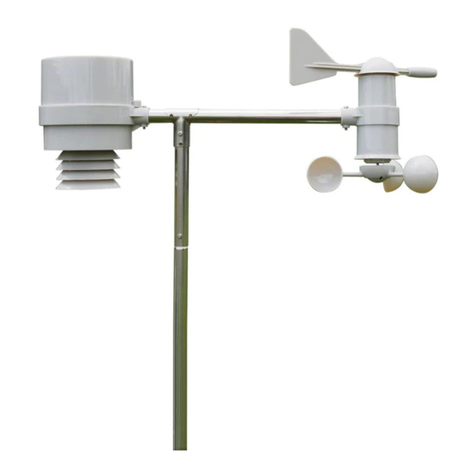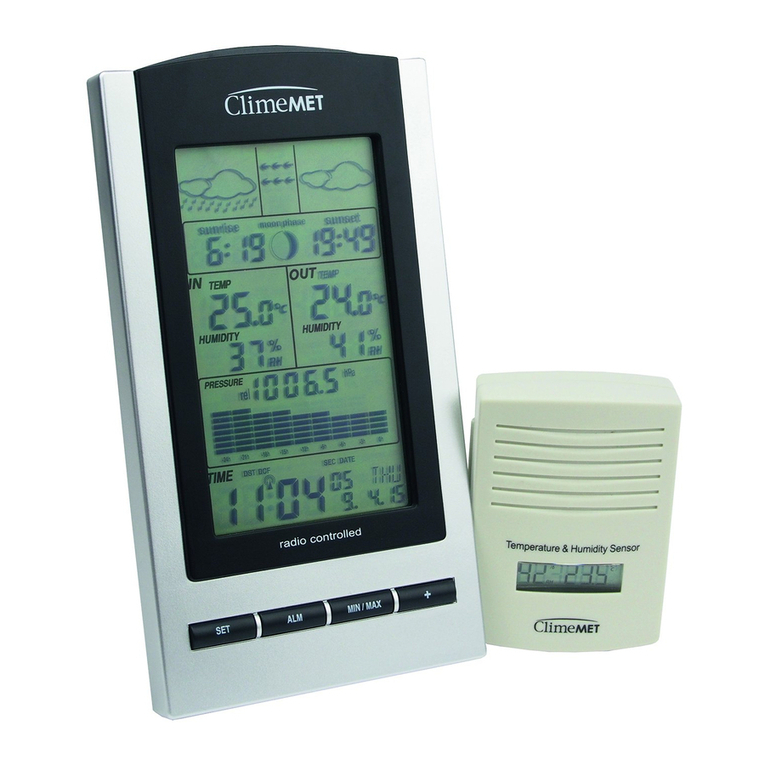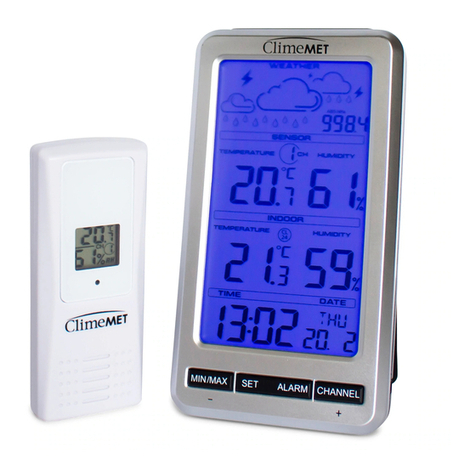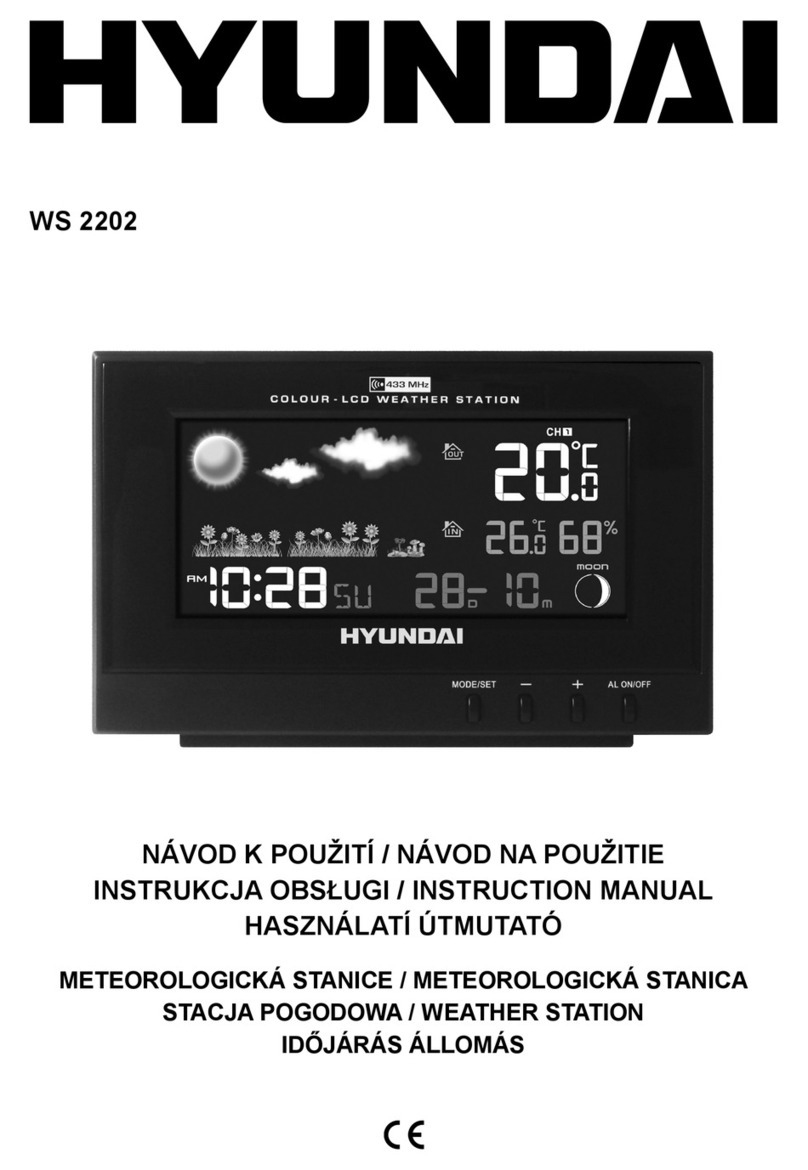ClimeMET CM9088 manual


CM9088 Wireless Desktop Weather Station
Welcome to the ClimeMET CM9088 Wireless Desktop Weather
Station.
Congratulations on the purchase of your new desktop weather station, the latest
in home weather technology from ClimeMET
Welcome to the ClimeMET CM9088 Desktop Weather Station. This system can
be set up to measure the indoor & outdoor temperature and humidity, pressure,
sunrise & sunset times and more at your location. You’ll be able to go back and
view maximum and minimum historical records, while you can also set various
alarms to let you know if and when certain conditions are met.
The CM9088 is packed with numerous features that will enable you to bring the
joy of the great outdoors into your home, so please make sure to begin by
reading through this manual in order to get the most out of your new weather
station.
Thank you for choosing ClimeMET.
This manual should be kept in a safe place for future reference as it
contains important notes on the setup and operation of your weather
station.
This handbook may contain mistakes and printing errors. The information in this
handbook is regularly checked and corrections made in the next issue. We accept
no liability for technical mistakes or printing errors, or their consequences. All
trademarks and patents are acknowledged.
01

CM9088 Wireless Desktop Weather Station
Contents
1. What’s in the Box?................................................................................. Page 3
2. Features................................................................................................... Page 4
3. Setup Guide............................................................................................. Page 5
3.1 Battery Installation ................................................................... Pages 5 & 6
3.2 Sensor Installation.................................................................... Pages 6 & 7
4. Display Console ............................................................................. Pages 7 & 8
4.1 Weather Forecasting ......................................................................... Page 9
4.2 Weather Tendency Indicator............................................................ Page 9
4.3 Examples of Changing Weather Icons ............................................ Page 9
4.4 Storm Warning Indicator.................................................................. Page 9
5. Program Mode...................................................................................... Page 10
5.1 Quick Display Mode ........................................................................ Page 10
5.2 Setting Mode .......................................................................... Pages 10 - 14
5.3 Setting Calibrated Humidity........................................................... Page 14
5.4 Setting Barometric Pressure.......................................................... Page 15
5.5 Alarm Mode ............................................................................ Pages 15 - 17
5.7 Sunrise and Sunset ......................................................................... Page 18
5.8 Minimum/Maximum Mode............................................................ Page 19
6. Support ....................................................................................... Pages 20 & 21
7. Product Specification ......................................................................... Page 22
02

CM9088 Wireless Desktop Weather Station
1. What’s in the Box?
> Weather Console
> Remote Sensor with Mounting Bracket
> Instruction Manual
You May Also Need:
> Three AA batteries for the weather console
> Two AAA batteries for the outdoor sensor
> Phillips Screwdriver for mounting your outdoor sensor
Please help in the preservation of the environment and return
used batteries to an authorized depot.
All rights reserved. This handbook must not be reproduced in any form, even in
excerpts, or duplicated or processed using electronic, mechanical or chemical
procedures without written permission of the publisher.
03

CM9088 Wireless Desktop Weather Station
2. Features
1) Wireless Outdoor and Indoor Temperature (°F or °C)
2) Wireless Outdoor and Indoor Humidity (%RH)
3) Records Min and Max Temperature
4) Records Min and Max Humidity
5) Barometric Pressure 24-hour History Graph (inHg or hPa)
6) Weather Tendency Arrow
7) Forecast Icons Based on Changing Barometric Pressure
8) DCF-1 Radio Controlled Time and Date with Manual Setting
9) Automatic Updates for Daylight Saving Time Based on Germany
DST System
10) Synchronized Instant Reception
11) 12 or 24-hour Time Display
12) Time Alarm with Snooze
13) Perpetual Calendar
14) LED Backlight
15) Wall Hanging or Free Standing
16) Low Battery Indicator
17) Sunrise Time
18) Sunset Time
19) Moon Phase
04

CM9088 Wireless Desktop Weather Station
3. Setup Guide
3.1 Battery Installation:
Note: To avoid operating problems, please take note of battery polarity be-
fore/when inserting any Alkaline Batteries (permanent damaged could be
introduced by inserting the battery in wrong direction). Use good quality Alkaline
Batteries and avoid rechargeable batteries.
1) Insert two AAA batteries into the remote sensor.
2) Insert three AA batteries into the weather station straight afterward.
3) Within 3 minutes (but probably sooner) the outdoor temperature
should be received by the weather station. Do not press any keys
before the outdoor sensor data is received.
4) Once the outdoor connection has been established, mount the units
ensuring that the receiver can still pick up the signal from the
transmitter. Position the remote sensor at the desired location
indoors/outdoors and it will transmit the temperature from its location.
Every time the remote sensor is powered up (for example after a change of
batteries) a random security code is transmitted that must be synchronized with
the base station to receive weather data. Therefore, if the batteries from the
remote sensor were changed, then the display console must also be powered
up again to re-learn the transmitter so it can receive data. The most effective
way to do this is to remove all batteries from both parts, wait one minute with
both units unpowered, then re-insert all batteries again within a 30-second time
period.
When the display console is powered up, a short beep will sound and all LCD
segments will light-up for 3 seconds before it enters learning-mode in order to
identify the remote sensors security code. Following this period, the base
station will then start the DCF radio controlled time reception. The console will
commence Radio-Controlled Clock reception period and no weather data
will be received during this period of time. If the RCC signal can’t be found
within 1 minute, the search process will be cancelled and will automatically
re-attempt every two hours until the signal is successfully received. The regular
radio-frequency link will be resumed once the RCC reception routine has been
completed.
05

CM9088 Wireless Desktop Weather Station
3.1 Battery Installation Continued:
Note: Please make sure not to press any keys during the initial learning-period
– if a key is pressed before the station receives the temperature signal, you will
need to follow the battery installation procedure again.
Please wait 10 seconds before re-inserting the batteries in order to ensure
both the transmitter and receiver have been allowed to completely reset.
Note for Radio Controlled Time:
The time and date display is based on the signal provided by the highly accurate
government operated atomic clock based in Frankfurt, Germany. The display
console will continue to scan for the radio controlled time signal each day, even
if the time has been set manually. If this reception has been unsuccessful, the
radio controlled time icon will not appear but reception will still be attempted
continually. If reception has been successful, the received time and date will
overwrite the manually-set time and date. If after setting the time manually
it appears to then ‘jump’ forward, it is possible that the unit has received
the radio-controlled time and overwritten the manual time setting. If this
happens, please check the Time Zone setting, as you may need to adjust this to
compensate for international time difference. To do this, press and hold the
SET key until the time changes to a flashing single digit (this will display ‘0’ by
default). Then, press either the ‘+’ or ‘MIN/MAX’ key to change the time zone
setting up and down accordingly.
Note: When batteries require replacement for the display console the low
battery indicator will light up on the LCD.
3.2 Sensor Installation:
1) Display Console
Using the foldable legs at the back of the unit, the
base station can be placed onto any flat surface.
It can also be wall mounted at the desired
position by using the hanging holes also found
at the back of the unit. It’s important to check
that the radio signal can be received successfully
before permanently mounting either of the
units.
06

CM9088 Wireless Desktop Weather Station
3.2 Sensor Installation Continued:
2) Remote sensor
Note: To achieve a true temperature reading, please try to avoid mounting
the remote sensor in direct sunlight. The outer casing of the sensor could
potentially heat up and then take time to cool again, resulting in false
temperature readings. We recommend that you install the remote sensor on
an outside North-facing wall. Remember that some obstacles such as thick
walls, concrete and large metal objects can reduce the transmission range.
To wall mount, use 3 screws to fix the wall bracket to the desired wall and then
simply plug the remote sensor into the bracket.
4. Display Console
The following illustration shows the full segments of the LCD for descriptive
purposes only – it will not appear like this during normal operation.
07

CM9088 Wireless Desktop Weather Station
4. Display Console Continued
1. Weather forecast icon
2. low battery indicator
3. MIN/MAX information
4. Sunrise time
5. Moon phase indicator
6. Sunset time
7. Indoor temperature low / high alarm
8. Indoor temperature display
9. Temperature display unit
10. Indoor humidity display
11. Indoor temperature and humidity alarm on indicator
12. Indoor humidity low / high alarm
13. Dew point temperature display
14. Outdoor temperature low/high alarm
15. Outdoor temperature and humidity alarm on indicator
16. Temperature display unit
17. Outdoor temperature display
18. Outdoor humidity display
19. Outdoor humidity low/high alarm
20. Absolute or relative air pressure selection
21. Barometer air pressure
22. Pressure with 24 hour history graph
23. Pressure high alarm
24. Pressure alarm on indicator
25. Pressure low alarm
26. Pressure display unit (inHg or hPa)
27. DCF, WWVB indicator
28. Radio Controlled Time icon
29. Time
30. Second
31. Day of week/ time zone
32. Alarm on indicator
33. Date (Y / M / D)
08

CM9088 Wireless Desktop Weather Station
4.1 Weather Forecasting:
The four weather icons Sunny, Partly Cloudy, Cloudy and Rainy are used for
weather forecasting. There are also two weather tendency indicators to show
the air pressure tendency between the displayed weather icons. The weather
forecasting is calculated from the changing air pressure.
4.2 Weather Tendency Indicator:
The weather tendency indicator arrow is located between the weather icons to
show the air pressure tendency and to provide a forecast of the upcoming
weather. The rightward arrow means that the air pressure is increasing and
weather is expected to generally become better. The leftward arrow means that
the air pressure is decreasing and the weather is expected to become worse.
The weather forecast icon is in accordance with the calculation between the
current relative-pressure and the on-going pressure change over the last six
hours. If a change is occurring, the weather tendency indicator (animated
arrows) will be flashing for three hours indicating that a change in the weather
is underway. If weather conditions have then become stable and no new
weather change conditions are met, the arrows will be fixed.
4.3 Examples of Changing Weather Icons:
4.4 Storm Warning Indicator:
The storm threshold can be set to suit the user’s requirement for storm
forecasting, from a sensitivity of between 3-9hPa (default 2hPa). Areas that
experience frequent changes in air pressure generally require a higher setting
compared to an area where the air pressure is calmer. For example, if 4hPa is
selected there must be a fall or rise in air pressure of at least 4hPa before the
weather station will register this as a change in weather.
09

CM9088 Wireless Desktop Weather Station
5. Program Mode
The display console uses five keys for operation: SET, ALARM, MIN/MAX, + and
SNOOZE/LIGHT.
There are also four program modes available: Quick Display Mode, Setting
Mode, Alarm Mode and Min/Max Mode.
The selected program mode can be exited at any time by either pressing the
SNOOZE/LIGHT key, or simply pressing no keys and waiting for the 10-second
time-out to take effect.
5.1 Quick Display Mode:
While in Normal Mode, press the SET key to enter the Quick Display Mode, you
then have the following options:
1) Switch between Outdoor Temperature/Dew point (pressing the MIN/MAX
key or +key shifts the display between outdoor temperature and dew
point).
Press the SET key again to switch to the pressure setting:
2) Switch between Absolute pressure / Relative pressure (pressing the
MIN/MAX key of the +key shifts display between the absolute pressure and
relative pressure).
Press the SET key to accept the change and toggle between these settings
then either press SNOOZE/LIGHT or wait 10 seconds to exit this program
mode.
5.2 Setting Mode:
- Hold the SET key for 3 seconds while in normal mode to enter Setting
Mode
- Press the SET key to scroll through the following in sequence:
1) DST (Daylight Savings Time) on/off. The DST (ON or OFF) setting will begin
flashing. Press the +key to toggle between DST ON and DST OFF.
2) Time Zone Setting. Press the SET key again to adjust the Time Zone (TZ)
setting.
Press the +key or MIN/MAX key to adjust the time zone from -12 to 12, based
on the number of hours from Coordinated Universal Time, or Greenwich Mean
Time (GMT).
10

CM9088 Wireless Desktop Weather Station
5.2 Setting Mode Continued:
The following table provides times zones throughout the world. Locations in the
eastern hemisphere are positive, and locations in the western hemisphere are
negative.
11
Hours
from GMT Time Zone Cities
-12 IDLW: International Date Line West ---
-11 NT: Nome Nome, AK
-10 AHST: Alaska-Hawaii Standard Honolulu, HI
CAT: Central Alaska
HST: Hawaii Standard
-9 YST: Yukon Standard Yukon Territory
-8 PST: Pacific Standard Los Angeles, CA, USA
-7 MST: Mountain Standard Denver, CO, USA
-6 CST: Central Standard Chicago, IL, USA
-5 EST: Eastern Standard New York, NY, USA
-4 AST: Atlantic Standard Caracas
-3 --- São Paulo, Brazil
-2 AT: Azores
Azores, Cape Verde Islands
-1 WAT: West Africa ---
0 GMT: Greenwich Mean London, England
WET: Western European
1 CET: Central European Paris, France
2 EET: Eastern European Athens, Greece
3 BT: Baghdad Moscow, Russia
4 --- Abu Dhabi, UAE
5 --- Tashkent
6 --- Astana
7 --- Bangkok
8 CCT: China Coast Bejing
9 JST: Japan Standard Tokyo
10 GST: Guam Standard Sydney
11 --- Magadan
12 IDLE: International Date Line East Wellington, New Zealand
NZST: New Zealand Standard

CM9088 Wireless Desktop Weather Station
5.2 Setting Mode Continued:
3) 12/24 hour format. Press the SET key again to adjust the 12/24 hour format
setting.
Press the +key to change between 12 hour and 24 hour format.
4) Latitude Location. Press the SET key again to adjust the Northern and
Southern Hemisphere settings. The icon LA (latitude) will appear in the Time
and Date field. Press the +key to change between NTH (northern
hemisphere) and STH (southern hemisphere).
Next, press the ALARM key to adjust the latitude whole number. Press the +key
or MIN/MAX key to adjust the latitude whole number up or down.
Press the ALARM key again to adjust the latitude decimal number. Press the +
key or MIN/MAX key to adjust the latitude decimal number up or down.
Note: To determine your latitude and longitude, we recommend visiting:
www.bing.com/maps
and enter your street address.
5) Longitude Location. Press the SET key again to adjust the Eastern and
Western Hemisphere settings. The icon LO (longitude) will appear in the
Time and Date field. Press the +key to change between EST (eastern
hemisphere) and WST (western hemisphere).
Next, press the ALARM key to adjust the longitude whole number x 100. Press
the +key or MIN/MAX key to adjust the longitude whole number x 100 up or
down.
Press the ALARM key again to adjust the longitude decimal number. Press the
+key or MIN/MAX key to adjust the longitude decimal number up or down
6) Manual time setting (hours/minutes). Press the SET key again to set the
hour. Press the +key or MIN/MAX key to adjust the hour up or down. Press
the SET key again to set the minute. Press the +key or MIN/MAX key to
adjust the minute.
12

CM9088 Wireless Desktop Weather Station
5.2 Setting Mode Continued:
7) Calendar setting (year /month /date). Press the SET key again to set the
calendar year. Press the +key or MIN/MAX key to adjust the calendar year.
Press the SET key again to set the calendar month. Press the +key or
MIN/MAX key to adjust the calendar month. Press the SET key again to set
the calendar day. Press the +key or MIN/MAX key to adjust the calendar
day (note that the display format is Month/Day/Year).
8) Temperature display unit degree Celsius or Fahrenheit. Press the
SET key again to toggle the temperature units from Celsius to Fahrenheit.
9) Indoor Temperature Calibration (default is measured indoor
temperature). Press the SET key to adjust the indoor temperature. Press
the +key or MIN/MAX key to adjust the temperature up or down in
0.1 degC (0.18 degF) increments.
To view the uncalibrated value, press the ALARM key while the
temperature is flashing.
10) Indoor humidity calibration. Press the SET key to adjust the indoor
humidity. Press the +key or MIN/MAX key to adjust the humidity up or
down in 1% increments. Please see Setting Calibrated Humidity notes below
for further information.
11) Outdoor Temperature Calibration (default is measured outdoor
temperature). Press the SET key to adjust the outdoor temperature. Press
the +key or MIN/MAX key to adjust the temperature up or down in 0.1
degC (0.18 degF) increments.
To view the uncalibrated value, press the ALARM key while the
temperature is flashing.
12) Outdoor humidity calibration. Press the SET key to adjust the outdoor
humidity. Press the +key or MIN/MAX key to adjust the humidity up or
down in 1% increments. Please see Setting Calibrated Humidity notes
below for further information.
To view the uncalibrated value, press the ALARM key while the humidity is
flashing.
13) Air pressure display units in hPa or inHg. Press the SET key again to
toggle the pressure units between hPa or inHg.
13

CM9088 Wireless Desktop Weather Station
5.2 Setting Mode Continued:
14) Relative pressure setting from 700hPa – 1100hPa (default 1013.5hPa). Press
the SET key to adjust the relative barometric pressure. Press the +key or
MIN/MAX key to adjust the relative barometric pressure up or down.
Please see Setting Barometric Pressure notes below for further
information.
15) Pressure threshold setting (default 2hPa). Press the SET key again to adjust
the pressure threshold setting. Press the +key or MIN/MAX key to adjust
the pressure threshold up or down.
16) Storm threshold setting (default 4hPa).Press the SET key again to adjust the
storm threshold setting. Press the +key or MIN/MAX key to adjust the
storm threshold up or down.
Note: Please set the units firstly before change units’ value. When changing the
unit setting, the value will convert accordingly but may cause resolution loss due
to the internal calculation-algorithm.
5.3 Setting Calibrated Humidity:
The display console allows you to calibrate both the indoor and outdoor
humidity. Humidity is a difficult parameter to measure accurately and drifts over
time - the calibration feature allows you to compensate for this. To calibrate
humidity, you will need an accurate source, such as a sling psychrometer or
whirling hygrometer.
To calibrate indoor humidity - In the Setup Mode with the indoor humidity
flashing, press the +key or the MIN/MAX key to increase or decrease the
humidity setting (in increments of 1%) to match the known humidity source. To
return the indoor humidity to the measured value, press and hold the SET key
for 3 seconds and the humidity will return to the uncalibrated value.
To calibrate outdoor humidity - In the Setup Mode with the outdoor humidity
flashing, press the +key or MIN/MAX key to increase or decrease the humidity
setting (in increments of 1%) to match the known humidity source. To return the
outdoor humidity to the measured value, press and hold the SET key for 3
seconds and the humidity will return to the uncalibrated value.
Note: The remote thermo-hygrometer will always display the measured
humidity level and not the calibrated humidity level. Only the console will show
this calibrated value.
Note: The dew point calculation is based on the calibrated humidity level.
14

CM9088 Wireless Desktop Weather Station
5.4 Setting Barometric Pressure:
The display console displays two different pressures: absolute (measured) and
relative (corrected to height above sea-level).
To compare pressure conditions from one location to another, meteorologists
correct pressure to sea-level conditions. Because the air pressure decreases as
you rise in altitude, the sea-level corrected pressure is generally higher than your
measured pressure.
Therefore your absolute pressure may read 28.62 inHg (969 mb) at an altitude
of 1000 feet (305 m), but the relative pressure is 30.00 inHg (1016 mb).
The standard sea-level pressure is 29.92 in Hg (1013 mb). This is the average
sea-level pressure around the world. Relative pressure measurements greater
than 29.92 inHg (1013 mb) are considered high pressure and relative pressure
measurements less than 29.92 inHg are considered low pressure.
To determine the relative pressure for your location, locate an official reporting
station near you (the internet is the best source for real time barometer
conditions, such as weather.com or wunderground.com), and set your weather
station to match the official reporting station.
To change this, while the relative pressure is flashing press the +key or
MIN/MAX key to increase or decrease the relative pressure setting to match the
official reporting station.
5.5 Alarm Mode:
- While in Normal Mode press the ALARM key to enter the High Alarm
Mode
- Press the ALARM key again to enter Low Alarm mode
After the initial pressing of the ALARM key the display will be refreshed to show
current high and low alarm value. The alarm value will be displayed only for
those already activated - all non-activated values will display ‘---‘ instead.
15

CM9088 Wireless Desktop Weather Station
5.5 Alarm Mode Continued:
- While In the High Alarm Mode, press the SET key to scroll through the
following alarm modes:
1. Time alarm (hour/minute)
2. Indoor humidity/high alarm
3. Indoor temperature high alarm
4. Outdoor humidity high alarm
5. Outdoor temperature and dew point high alarm
6. Pressure high alarm
- In the Low Alarm mode press the SET key to scroll through the following
alarm modes:
1. Time alarm (hour/minute)
2. Indoor humidity low alarm
3. Indoor temperature low alarm
4. Outdoor humidity low alarm
5. Outdoor temperature and dew point low alarm
6. Pressure low alarm
- When the desired alarm mode is selected, press the +key or MIN/MAX
key change or toggle the alarm value. Holding the +key or MIN/MAX
key for 3 seconds will change the figure in larger amounts. Press the
ALARM key to then choose if the alarm is on or off (if the alarm is
enabled, the speaker icon on the LCD will be displayed to indicate this).
Press the SET key to confirm the setting and continue pressing the SET
key to toggle through the remaining alarm modes until it returns to the
normal display mode.
- Remember - you can press SNOOZE/LIGHT key or leave the keys alone
for 10 seconds at any time and the alarm mode will return to Normal
Mode.
Cancelling the Temperature Alarms
a. When an alarm condition has been met, that particular alarm will
sound and flash for 120 seconds. At this point, simply press any key to
mute the alarm. If the alarm condition is activated again within 10
minutes, the alarm will not sound again but will continue to flash
until weather conditions have stabilized.
This feature will prevent repeated alarms sounding for the same value
being triggered in a short period of time.
b. The alarm will then reactivate automatically once the value has fallen
below the set limit or if a new value is entered instead.
16

CM9088 Wireless Desktop Weather Station
5.5 Alarm Mode Continued:
The Outdoor Weather Alarm
When an outdoor weather alarm has been triggered it will flash on the LCD
display. The primary outdoor alarm icon and high/low alarm icon will also flash
accordingly. For example, in the outdoor temperature display mode when then
dew point high alarm is triggered, the DEW POINT icon will flash along with the
outdoor & high alarm icons, confirming that the current alarm is relating to high
dew point.
5.6 Moon Phase:
The following moon phases are displayed based on the calendar date.
17

CM9088 Wireless Desktop Weather Station
5.7 Sunrise and Sunset:
To determine your longitude and latitude,we recommend the following website:
www.bing.com/maps
Reference Figure 5 below:
1. Enter your address and select the search button
2. The latitude (first number) and longitude (second number) are returned.
In this example:
Latitude=33.2981181889772
Longitude=-111.960209459066
The table below of defines the hemisphere based on the positive or
negative sign:
3. In this example, the location entered into the display is as below:
Latitude = 33.30 North
Longitude = 111.96 West
after rounding to two signification digits.
Record your longitude and latitude here for future reference:
18
Positive Positive Negative
Latitude Northern Southern
Longitude Eastern Western
1
2
Latitude:
Longitude:

CM9088 Wireless Desktop Weather Station
5.8 Minimum/Maximum Mode:
- While in Normal Mode, press the MIN/MAX key to enter the maximum
mode. The MAX logo and the general Max record will then be
displayed.
- Press the MIN/MAX key again to enter the minimum mode. The MIN
icon and minimum record will now be displayed instead.
- Press the MIN/MAX key once again to return to Normal Mode.
In the Maximum reading mode, press the +key to display the following
maximum values along with the time and date at which these values were
recorded:
1. Indoor humidity
2. Indoor temperature
3. Outdoor humidity
4. Outdoor temperature
5. Dewpoint
6. Pressure
In the Minimum reading Mode, press the +key to display the following minimum
values together with the time and date at which these values were recorded:
1. Indoor humidity
2. Indoor temperature
3. Outdoor humidity
4. Outdoor temperature
5. Dewpoint
6. Pressure
- While in the Minimum or Maximum mode, press the SET key for 2
seconds and the Minimum or Maximum record that is showing will be
reset to the current reading.
- Press the SNOOZE/LIGHT key or wait 10 seconds and the Min/Max
mode will return to Normal Mode.
19
Other manuals for CM9088
1
Table of contents
Other ClimeMET Weather Station manuals
Popular Weather Station manuals by other brands
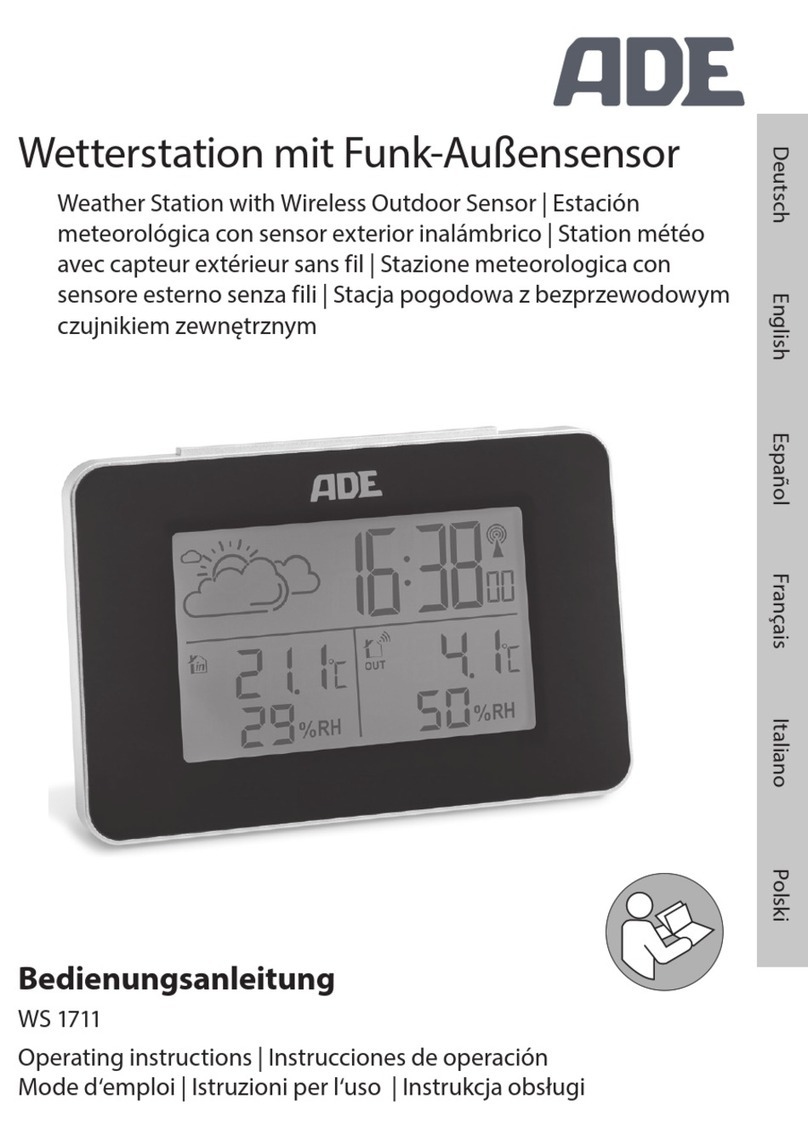
ADE
ADE WS 1711 operating instructions
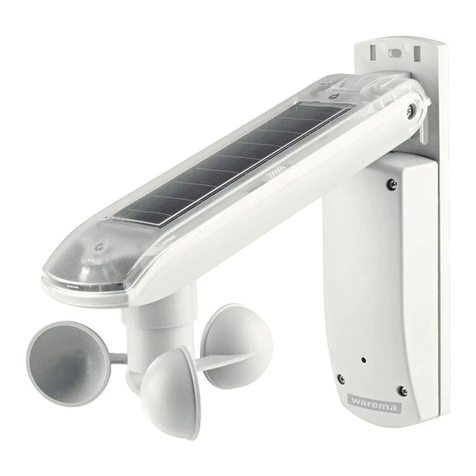
WAREMA
WAREMA EWFS Weather station eco Operating and installation instructions

Auriol
Auriol z29592 Operation and safety notes

Auriol
Auriol 296289 Operation and safety notes

Hyundai
Hyundai WS 2266 instruction manual
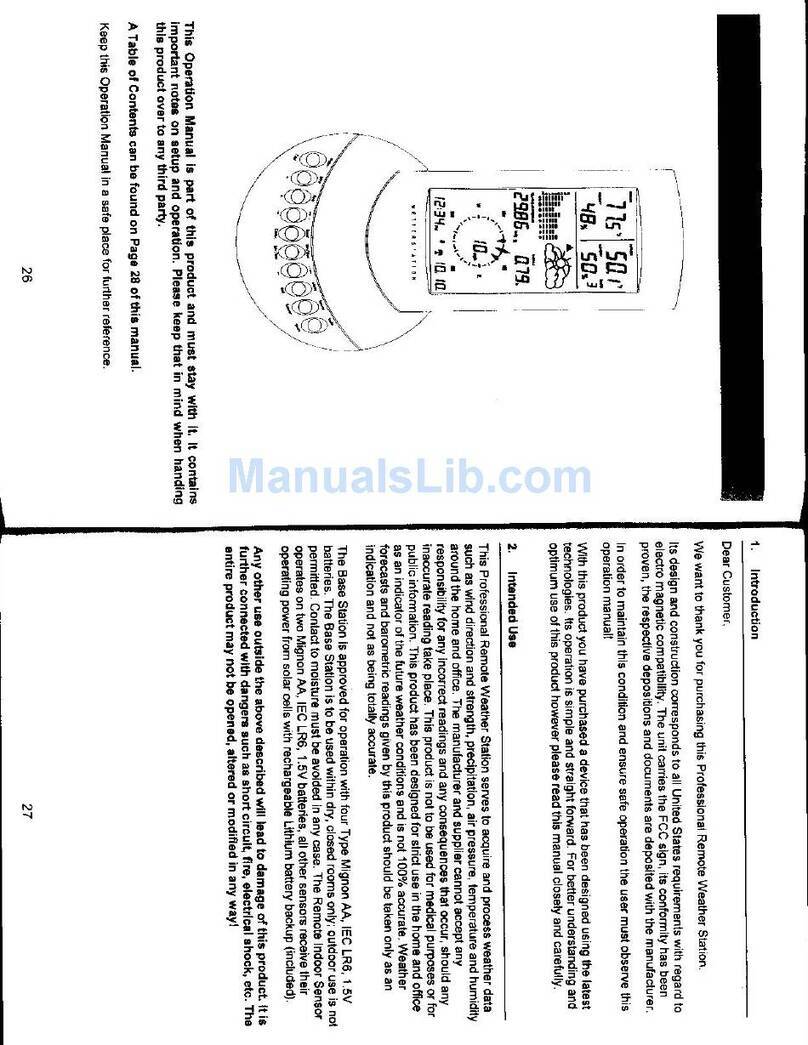
La Crosse Technology
La Crosse Technology WS-2210 Operation manual
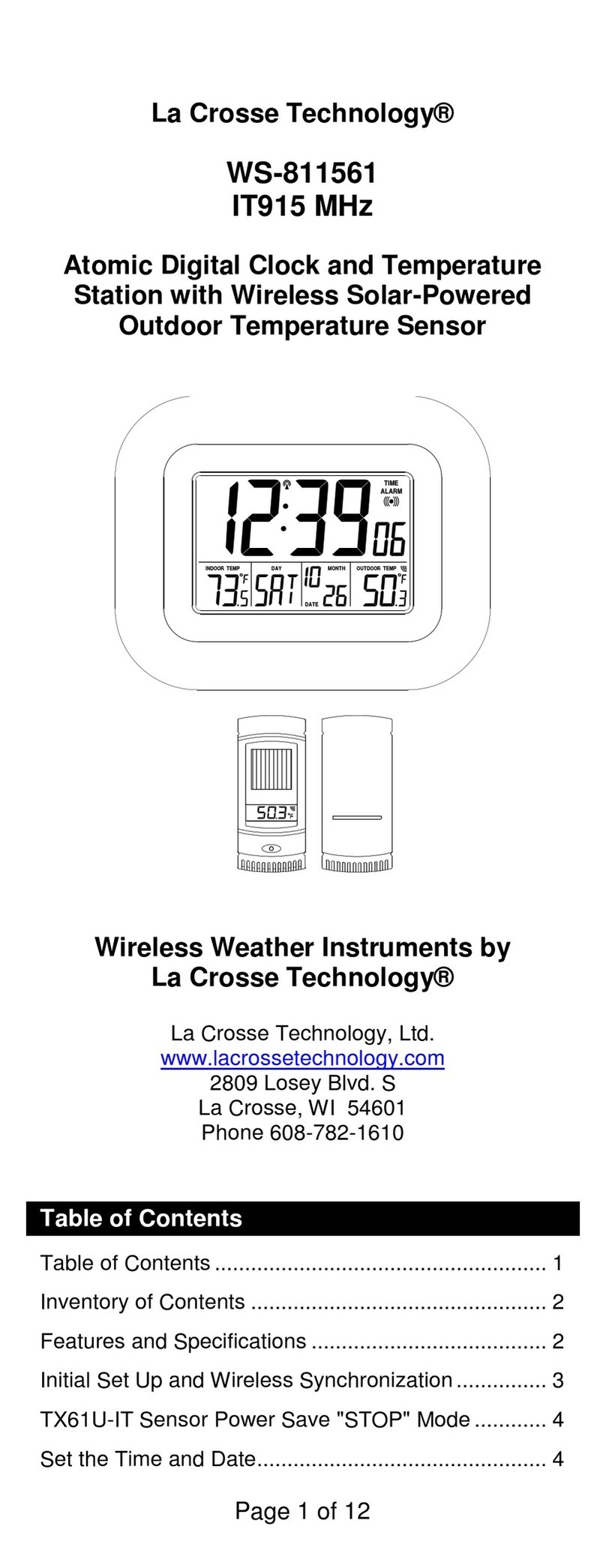
La Crosse Technology
La Crosse Technology WS-811561 manual
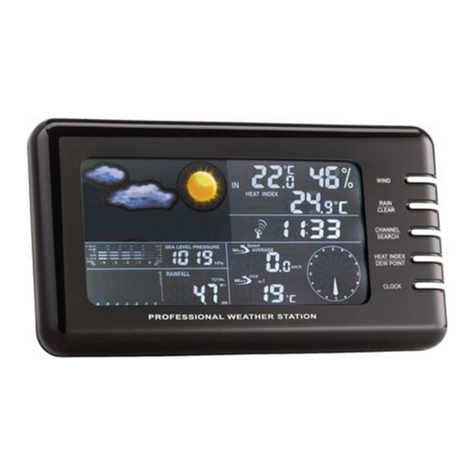
Ventus
Ventus W177 owner's manual
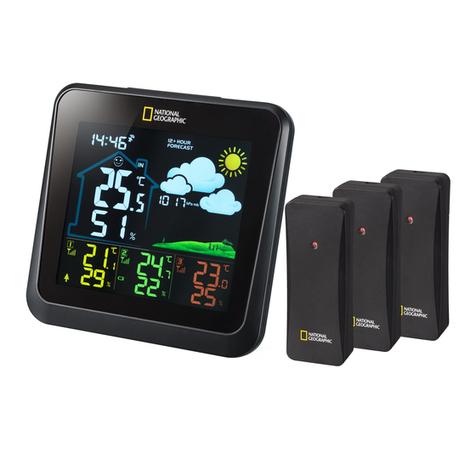
National Geographic
National Geographic VA Colour RC instruction manual
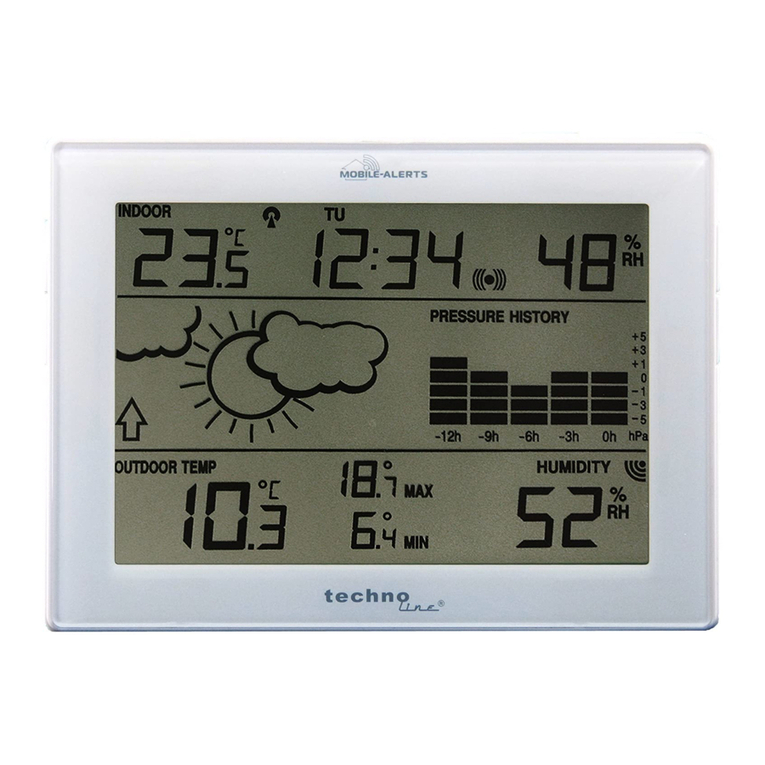
Instant Transmission
Instant Transmission MA 10410 instruction manual
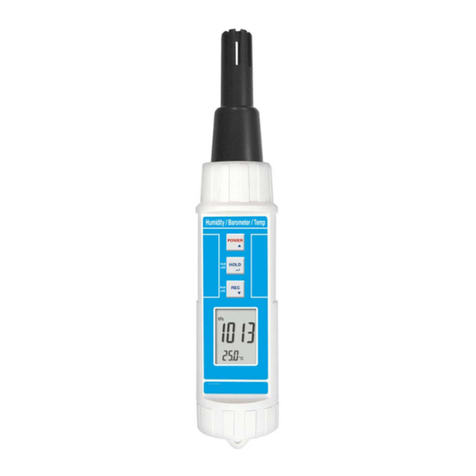
Lutron Electronics
Lutron Electronics PHB-318 Operation manual

Oregon Scientific
Oregon Scientific Alizé BAR266 user manual
